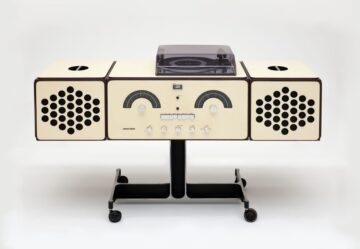
Originally published in the Marina Times San Francisco in May 2024
Art of Noise Exhibit at SFMOMA Celebrates Groundbreaking Music Design
SFMOMA’s Art of Noise pays homage to the images that accompany our musical experiences. The exhibit features over 800 artworks and four audio installations, record albums and concert posters plus the phonographs and hand held radios that played the music. The visual aesthetics associated with concert posters, album art and stereos merged with the songs, acting as the signposts mapping our memories, the times and places, through moments of sound.
Music as Collective Experience
Dazzling floor-to-ceiling installations of rock posters and album covers will transport the museumgoer through the history of music. Joseph Becker, associate curator of architecture and design, noted “The San Francisco Bay area has been an influential center for graphic and industrial design, including audio products that merge aesthetics and engineering, and era-defining posters and fliers. SFMOMA’s design collection reflects these local strengths, as well as iconic designs from around the world, which can be seen in the hundreds of surprising and familiar works on view in Art of Noise.”
Instantly recognizable album covers and posters reflect on our collective cultural experiences. SFMOMA will include their trove of psychedelic rock posters from the 60’s and 70’s, some seen together for the first time. Graphic designer Milton Glaser’s best-known work, a 1966 poster of Bob Dylan, will be on display. Designed for Bob Dylan’s Greatest Hits album, this was one of Glaser’s first posters. The image has been sold and duplicated in the millions, and remains one of the best-known representations of Bob Dylan. Perhaps the most famous of the “Fillmore Posters” in the psychedelic scene of San Francisco in the late 60’s was created by Bonnie MacLean. Her vividly colored playbills were rendered in an Art Nouveau style, letters curving around her stylized imagery. Her best-known work was her poster The Yardbirds and The Doors at the Fillmore Auditorium; San Francisco, July 25-30, 1967. Mid-Century Modernist graphic designer record sleeves and album covers are included by Laini (Sylvia) Abernathy, Emmet McBain, Reid Miles and others. Also on view are iconic music advertisements that are part of our collective memory, as well as fliers and placards that announce moments from hip-hop, punk and rave culture with an emphasis on concerts and performances in the Bay Area.
A Immersive History of Playback
Museumgoers will follow the evolution of playback, from early phonographs and transistor radios to high-fi stereos. Turntables with sculptural brilliance such as the Op Art masterpiece Rosita Vision 200 by Thilo Oerke and Rosita Tonmobel will be on display. Achille and Pergiacomo Castiglioni’s RR126 Stereo System’s symmetrical beauty flawlessly combines form and function. Time travel back to the days of the Sony Walkman and the Apple iPod. These engineering milestones have radically transformed how, where and when we can enjoy listening to music. A sound installation specifically designed for SFMOMA Devon Turnbull (OJAS) called HiFi Pursuit Listening Room Dream No. 2 is a functional sculpture that facilitates exceptionally high-fidelity music playback. The immersive audio experience will be activated through a series of performances with renowned record collectors, musicians and music labels, drawing heavily on the Bay Area’s robust music culture and history.
Another cutting-edge listening experience is Choir, a set of sonic sculptures programmed to sing together as a choral group, with each sculpture possessing a unique vocal range. Experimental works like Ron Arad’s Concrete Stereo presents a cracked, fractured stereo system built from concrete fragments with an overall aesthetic of an abandoned building, challenging the idea of portability and functionality. Some stereo systems don’t resemble stereo systems at all, like Power of Love by Mathieu Lehanneur, a golden flame-shaped music player with a shining patina reminiscent of a holy relic.
As part of the exhibition, visitors will encounter the commissioned project Arborhythm, by Yuri Suzuki, in two locations: on the publicly accessible Floor 2 terrace near the museum’s Howard Street entrance and on the Floor 7 terrace, adjacent to Art of Noise. The experimental artwork consists of treelike sculptures of yellow, orange and green metal tubes resembling horns, functioning as a seating structure and a sonic landscape.
Be sure to enjoy a Free Community Day at SFMOMA on Saturday May 4 at 10am-5pm with free admission to the entire museum including musical performances and other activities.